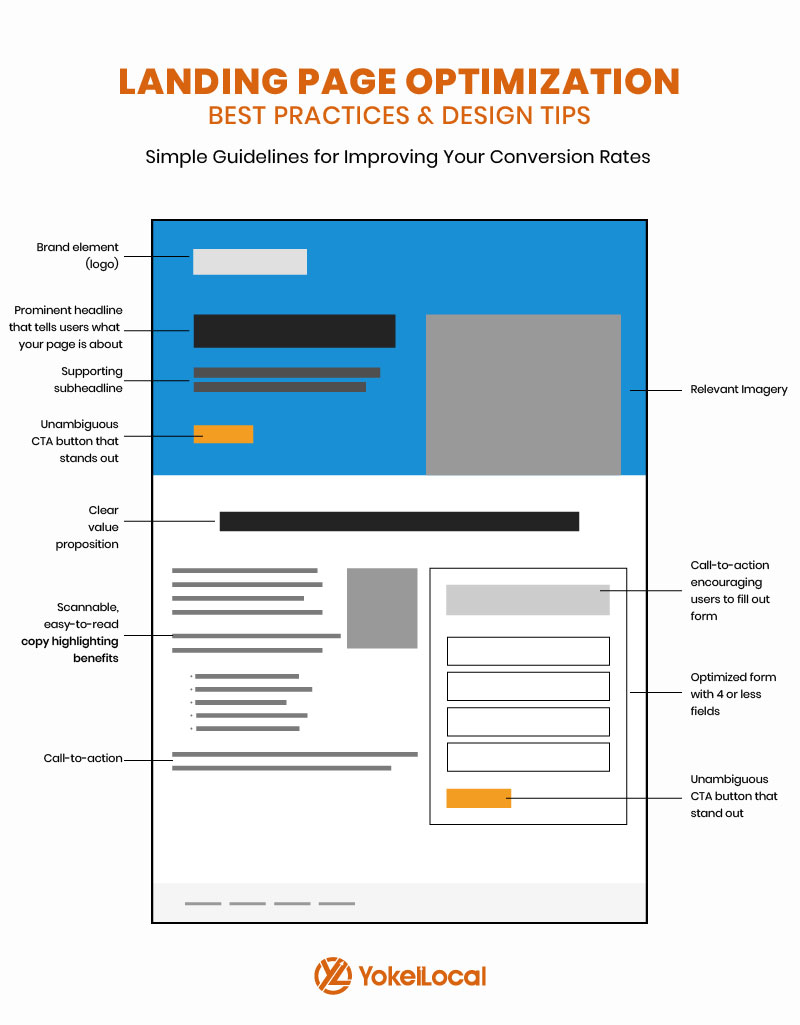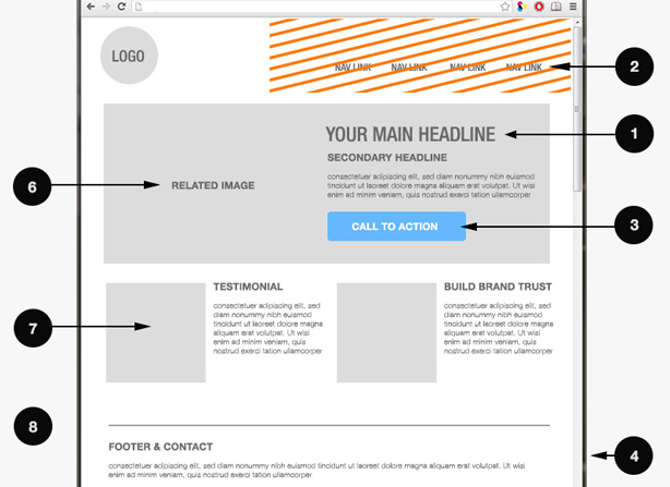Creating a landing page that converts visitors into customers is essential. Effective landing pages can boost your marketing efforts significantly.
A well-designed landing page is the key to capturing leads and driving sales. It’s not just about aesthetics but also about functionality and user experience. Visitors should find what they need quickly and easily. This involves a mix of clear messaging, compelling calls to action, and a streamlined layout.
Understanding the best practices for landing pages can help you create a page that meets your business goals. Whether you’re new to this or looking to improve your current landing page, these tips will guide you in the right direction. Let’s dive into the essentials that make a landing page effective and successful.
Introduction To Landing Pages
A landing page is a standalone web page. It is created for marketing or advertising campaigns. Visitors “land” on this page after clicking a link in an email, ad, or other digital location. Landing pages are designed to convert visitors into leads or customers. Unlike other web pages, a landing page has a single focus or goal, known as a call-to-action (CTA).
Importance Of Landing Pages
Landing pages are crucial for online marketing. They help in converting visitors into leads. They capture information through forms. Without landing pages, it is hard to track the effectiveness of campaigns. They provide a controlled environment, free from distractions. This focus increases the chance of conversion.
Key Objectives
The main objectives of landing pages include:
- Lead Generation: Collect visitor information through forms.
- Sales: Encourage visitors to make a purchase.
- Brand Awareness: Introduce visitors to your brand.
- Event Promotion: Drive registrations for events.
| Objective | Primary Action |
|---|---|
| Lead Generation | Form Submission |
| Sales | Purchase |
| Brand Awareness | Engagement |
| Event Promotion | Registration |
Each objective requires a specific CTA. For instance, a lead generation page may ask for an email address. A sales page might include a “Buy Now” button. Clear and concise CTAs are essential. They guide visitors toward the desired action.
Crafting A Compelling Headline
Crafting a compelling headline is crucial for landing page success. It grabs attention and sets the tone for the content. Engage visitors immediately with clear, concise language.
Creating a powerful headline is essential for your landing page. It sets the tone and grabs the reader’s attention. A compelling headline can make the difference between a visitor staying or leaving.Grab Attention
Your headline should catch the eye immediately. Use strong, action-oriented words. Keep it short and to the point. A good headline sparks curiosity. It makes the visitor want to read more. Avoid complex words or jargon. Simple language works best.Convey Value
Your headline must offer clear value. It should tell the visitor what they will gain. Highlight the benefits of your product or service. Avoid vague statements. Be specific and direct. The value should be obvious at a glance. This helps build interest and trust quickly. “`Effective Use Of Visuals
Visuals play a critical role in the effectiveness of a landing page. They capture attention, convey messages quickly, and can lead to higher conversion rates. Using the right visuals can significantly improve user experience and engagement.
High-quality Images
High-quality images are essential for a successful landing page. They should be relevant and resonate with your audience. Clear, vibrant images can build trust and create a positive first impression. Avoid using stock photos that look too generic. Instead, opt for original photos or well-chosen stock images that fit your brand.
Videos For Engagement
Videos can greatly enhance user engagement on your landing page. They can explain complex concepts quickly and keep visitors on your page longer. Short, informative videos that highlight key benefits or features can be very effective. Ensure your videos are of high quality and load quickly to prevent losing user interest.
Optimizing Call-to-action
Optimizing your Call-to-Action (CTA) is crucial for a successful landing page. A well-placed, clear, and engaging CTA can significantly improve conversion rates. Ensuring your CTA stands out and prompts action is essential. Below are some best practices for optimizing your CTA.
Cta Placement
Where you place your CTA affects its visibility and effectiveness. Ideally, the CTA should be above the fold. This means visitors should see it without scrolling. Place the CTA in a prominent position, such as:
- At the top of the page
- In the center of the screen
- Next to compelling content
Consider using multiple CTAs for long landing pages. You can place them at:
- The beginning
- The middle
- The end
This ensures visitors always have a clear action to take.
Action-oriented Language
Your CTA text should use action-oriented language. It should tell the user exactly what to do. Use verbs to create a sense of urgency. Here are some examples:
- Sign up now
- Get started
- Download free guide
Keep the language simple and direct. Avoid jargon or complex words. The goal is to make the action clear and easy to understand. Use strong verbs and keep the message concise.
Remember, optimizing your CTA involves both strategic placement and compelling language. Make your CTA impossible to miss and irresistible to click.
Design And Layout Tips
Creating an effective landing page requires attention to design and layout. A well-designed landing page can help convert visitors into customers. Below are some key tips to keep in mind for your landing page design and layout.
Simple And Clean Design
A simple and clean design is essential. Avoid clutter. Use plenty of white space. This helps keep the focus on your message. Limit the use of colors and fonts. Stick to a consistent style. This makes your page look professional.
Visual hierarchy is important. Highlight the most important elements. Use larger fonts for headings. Place key information above the fold. This ensures visitors see it right away.
Mobile Responsiveness
Mobile responsiveness is crucial. More people browse on mobile devices. Ensure your landing page looks good on all screen sizes. Test your design on different devices. Make sure buttons and links are easy to tap. Use responsive design techniques.
Keep load times short. Optimize images and other media. Slow pages can drive visitors away. A fast, responsive page keeps users engaged.
Building Trust And Credibility
Landing pages aim to convert visitors into customers. To do this, you need to build trust and credibility. Your visitors need to feel confident in your business. They should believe that your product or service meets their needs. Two key elements can help achieve this: customer testimonials and trust badges.
Customer Testimonials
Customer testimonials are powerful. They show real people have used your product and liked it. These testimonials can make new visitors trust your brand more. Here’s how to use them effectively:
- Real Names and Photos: Use actual names and photos. This makes testimonials more believable.
- Specific Results: Include specific results or benefits. This shows real value.
- Short and Sweet: Keep testimonials short. Long testimonials can be overwhelming.
Here’s an example table for displaying testimonials:
| Name | Testimonial | Photo |
|---|---|---|
| John Doe | “This product changed my life. I saw results in a week.” |  |
| Jane Smith | “Excellent customer service and a great product. Highly recommend!” |  |
Trust Badges
Trust badges are symbols that show your website is secure. They also show that your business is reliable. Use these badges to build trust:
- Security Badges: Display badges from SSL certificates. This shows your site is secure.
- Payment Badges: Use badges from known payment providers. Examples include PayPal and Visa.
- Affiliation Badges: Show badges from any industry associations. This shows you meet industry standards.
Here is an example of how you can display these badges:
Each badge adds a layer of trust. Visitors feel safer on your site. This can lead to higher conversions.
A/b Testing Strategies
A/B testing is essential for optimizing landing pages. It helps you understand which elements work best. By testing different variations, you can improve user experience and conversion rates. This section covers A/B testing strategies for your landing page.
Test Different Elements
Start by testing one element at a time. Focus on headlines, images, and calls to action. Change the headline to see if it captures more attention. Try different images to find the most engaging one. Test various call-to-action buttons to see which gets more clicks.
Other elements to test include form length and colors. A shorter form may lead to more submissions. Different colors can affect user behavior. Keep tests simple and direct.
Analyze Results
After testing, analyze the results carefully. Look at metrics like click-through rates and conversions. These numbers show which version performs better. Use tools like Google Analytics to gather data.
Focus on statistical significance. A small difference might not be meaningful. Ensure you have enough data to draw reliable conclusions. This helps make informed decisions for future tests.

Credit: www.yokellocal.com
Improving Page Load Speed
Improving page load speed is crucial for a landing page’s success. Users expect fast-loading pages. Slow pages lead to higher bounce rates. To keep visitors engaged, ensure your landing page loads quickly. Below are some best practices to enhance page load speed.
Minimize Media Files
Large media files can slow down your page. Resize images before uploading. Use formats like JPEG for photos and PNG for graphics. Consider using SVG for simple icons. Compress images using tools like TinyPNG. This reduces file size without losing quality. For videos, use modern formats like MP4. Host videos on platforms like YouTube or Vimeo. Embed them on your page instead of uploading directly.
Optimize Code
Clean, efficient code helps your page load faster. Remove unnecessary comments and spaces in your HTML, CSS, and JavaScript files. Use a minifier to reduce file sizes. Combine multiple CSS or JavaScript files into one. This reduces HTTP requests. Leverage browser caching to store files locally. This way, returning visitors experience faster load times. Use asynchronous loading for JavaScript. This ensures scripts load without blocking the rest of the page. Implement lazy loading for images and videos. This loads media only when the user scrolls to them.
Analyzing Performance Metrics
Analyzing performance metrics is essential for improving your landing page. It helps you understand user behavior and optimize for better conversions. Use data to make informed decisions and enhance the user experience. Let’s explore some key areas in performance analysis.
Track User Behavior
Tracking user behavior provides insights into how visitors interact with your landing page. Tools like Google Analytics and Hotjar can help.
Consider tracking these key metrics:
- Page Views: The number of times your page is viewed.
- Average Time on Page: How long users stay on your page.
- Bounce Rate: The percentage of users who leave after viewing one page.
Analyzing these metrics can identify areas for improvement. For instance, a high bounce rate may indicate that your content is not engaging enough.
Conversion Rate Optimization
Conversion Rate Optimization (CRO) focuses on increasing the percentage of visitors who complete desired actions. These actions could be filling out a form, signing up for a newsletter, or making a purchase.
Follow these best practices for effective CRO:
- Clear Call-to-Action (CTA): Ensure your CTA is visible and compelling.
- Simple Forms: Keep forms short and easy to fill out.
- Trust Signals: Include testimonials, reviews, and security badges.
Test different elements on your landing page to see what works best. A/B testing can help you compare variations and choose the most effective design.
Here’s a simple table to illustrate some key metrics:
| Metric | Description | Goal |
|---|---|---|
| Page Views | Number of times the page is viewed | High |
| Average Time on Page | Average duration a user spends on the page | High |
| Bounce Rate | Percentage of users who leave after one page | Low |
Monitoring and analyzing performance metrics is crucial. It helps you create an effective landing page that drives results.

Credit: www.aztekweb.com
Final Thoughts
To sum up, incorporating best practices for landing pages can significantly boost engagement and conversions. Focus on clear messaging, strong visuals, and a compelling call-to-action.
Creating an effective landing page involves many elements. Each one plays a crucial role. From clear headlines to compelling calls-to-action, every detail matters. Following best practices ensures your landing page converts visitors into leads or customers. Let’s review the key points.Summary Of Best Practices
A strong headline grabs attention. Use clear, concise language. Your value proposition should be obvious. Explain what users gain. Visuals should support your message. Keep the design simple. Too much clutter distracts visitors. Ensure your call-to-action stands out. Use contrasting colors. The text should be action-oriented. Make sure the form fields are minimal. Only ask for necessary information. Test different versions to find what works best.Encouragement To Experiment
Best practices provide a solid foundation. But don’t stop there. Each audience is unique. What works for one may not work for another. Keep testing new ideas. Use A/B testing to measure success. Small changes can make a big difference. Learn from your data. See what engages your visitors. Tweak your approach. Never assume you’ve found the perfect formula. The digital world changes fast. Stay flexible and creative. Keep improving your landing page. “`
Credit: www.getresponse.com
Frequently Asked Questions
What Is A Landing Page?
A landing page is a standalone web page created specifically for marketing or advertising campaigns. It captures visitor information.
Why Are Landing Pages Important?
Landing pages are crucial for conversions. They guide visitors toward a specific call-to-action, increasing leads and sales.
How To Create Effective Landing Pages?
Effective landing pages have clear headlines, strong calls-to-action, engaging visuals, and concise content. They also use trust signals.
What Should A Landing Page Include?
A landing page should include a compelling headline, subheadline, benefits, visuals, and a call-to-action. Testimonials help too.
Conclusion
Creating effective landing pages can boost your site’s success. Focus on clear headlines. Use engaging visuals. Highlight benefits and keep forms simple. Ensure your page loads quickly. Mobile optimization is crucial. Test different elements regularly. Analyze your results and adjust accordingly.
These practices can improve user experience. A better user experience often leads to higher conversions. By following these tips, you enhance your landing page’s effectiveness. Always aim to meet your audience’s needs. Thank you for reading!

I am a passionate digital marketer with a strong expertise in SEO and article writing. With years of experience in crafting compelling content and optimizing it for search engines, I help businesses enhance their online visibility and drive organic traffic. Whether it’s creating engaging blog posts or implementing effective SEO strategies, I am dedicated to delivering results that make an impact.
